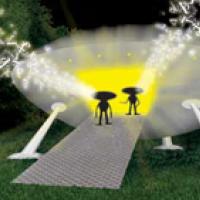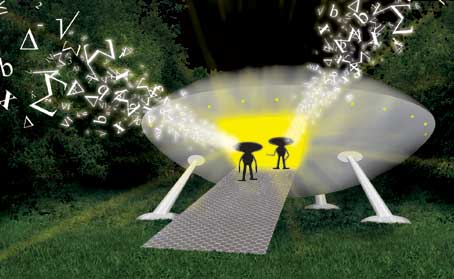
Maths in a minute: Peano arithmetic
There's nothing simpler than 1,2,3, ... we understand these numbers instinctively and that's why they're called the natural numbers. But if you really think about it, what are these numbers? How would you describe them to an alien devoid of a number instinct? Here's one way of defining them, developed by the Italian mathematician Giuseppe Peano:

Explaining numbers to aliens.
- First you proclaim that 1 is a natural number
- Then you say that every natural number n has a successor s(n), which you can also write as n+1.
- We also insist that this successor is never equal to 1
- And that different numbers have different successors.
These four rules give you all the natural numbers, neatly ordered in a line, starting from 1 (you could also have started from 0). They also give you arithmetic, since addition and multiplication are about repeatedly adding 1s and you know how to do this: you simply move up to the successor of the number you're looking at. Subtraction and division are just the reverse of addition and multiplication. So equipped with these rules your innumerate alien could actually do some pretty decent number theory.
The four rules form the basis of what's called Peano arithmetic. It's a formal mathematical system based on a set of axioms (which includes these four rules) together with a language in which to speak about numbers and rules for logical inference. In the beginning of the 20th century mathematicians hoped they could turn all of maths into one giant formal system similar to Peano's arithmetic. That way they could prove everything directly from the axioms, without any hidden assumptions, and make sure that maths contains no contradictions. But their dream was shattered in the 1930s by the logician Kurt Gödel, who showed that there are logical limits to what you can do using formal systems. Find out more in
Comments
Chris
My suggestion for linking formal logic and natural numbers is to see counting 1 2 3 4 5 6 and so on as a series of propositions each of which contradicts and updates the previous. There's 1 sheep in the field. Oh no there isn't, there are 2. Oh no, I've just spotted another, so 3. Hold on, there aren't 3 but 4. And so on.
In formal logic this could be expressed as P, Q ⊃ not-P, R, R ⊃ not-Q, . . .. The material implication symbol "⊃" can be interpreted as the updating function. The conventional two-valued truth table for this function whereby 1 1 = 1, 0 1 = 1, 1 0 = 0, 0 0 = 1, means that 1 0 is a failure to update.